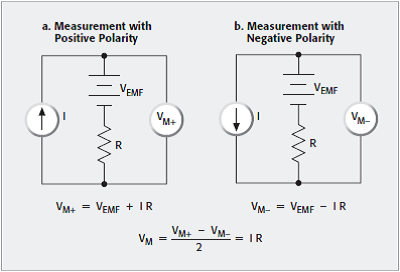

One of the questions we hear often from customers is to explain the difference between measuring low resistances using an offset compensation mode or a delta mode. What is current-reversal? Why do I need to use these techniques? Can I use these methods with a SourceMeter? This is a topic I would like to spend some time on so you can make the best choice of which technique to use.
Why do I need to use these techniques and when?
The reduction or elimination of thermoelectric voltages are probably the main reason for using these techniques. Thermoelectric voltages (thermoelectric EMFs) are voltages generated when different parts of a circuit are at different temperatures and when conductors made of dissimilar materials are joined together. A few microvolts of thermal voltages can be generated by temperature gradients in the test circuit caused by fluctuating temperatures in the lab or a draft near the sensitive circuitry. But there are measurement techniques which you can use to overcome these unwanted offsets. They are the current-reversal method, the delta method, and the offset-compensated ohms.
What is the Current-Reversal Method?
Thermoelectric EMFs can be canceled by making two measurements with currents of opposite polarity, as shown in the figure below.
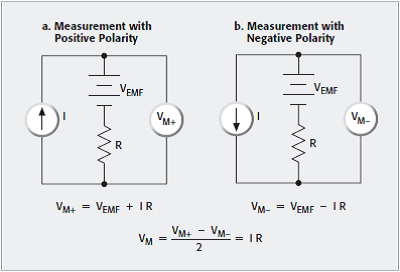
With the positive current applied as in Figure a, the measured voltage is:
VM+ = VEMF + IR
Reversing the current polarity as shown in Figure b yields the following voltage measurement:
VM– = VEMF – IR
The two measurements can be combined to cancel thermoelectric EMFs:

The measured resistance is computed in the usual manner:
R = VM / I
Note that the thermoelectric voltage (VEMF) is completely canceled out by this method of resistance calculation.
For the current-reversal method to be effective, it’s important that the SourceMeter response speed is fast compared with the thermal time constant of the circuit under test. If the response speed is too slow, any changes in the circuit temperature during the measurement cycle will cause changes in the thermoelectric EMFs that won’t be completely canceled, and some error will result. All of Keithley’s SourceMeters have fast response speeds that you can count on.
What is the Offset Compensated Ohms Method?
Another offset-canceling method used by DMMs and is built into Keithley’s SourceMeters, such as the Keithley Model 2450, 2460, or the just introduced 2461, is the Offset Compensation ohms method as shown below. This method is similar to the current-reversal method except that the measurements are alternated between a fixed source current and zero current.
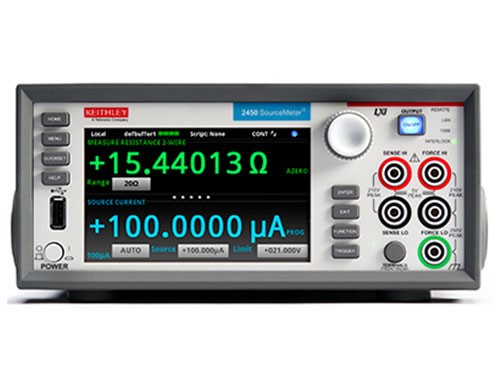
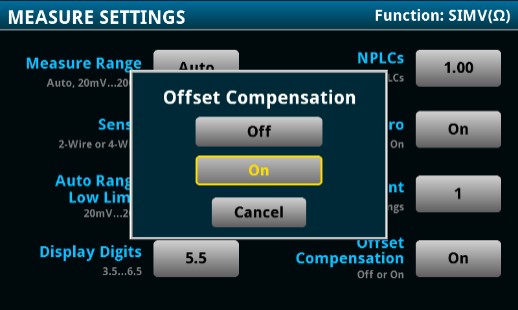
As shown below, the source current is applied to the resistance being measured during only part of the cycle.
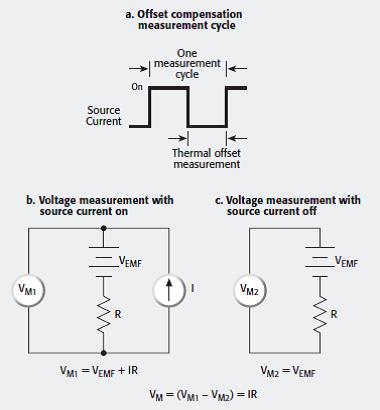
When the source current is on, the total voltage measured by the instrument includes the voltage drop across the resistor as well as any thermoelectric EMFs, and it is defined as:
VM1 = VEMF + IR
During the second half of the measurement cycle, the source current is set to zero amps and the only voltage measured by the meter is any thermoelectric EMF present in the circuit:
VM2 = VEMF
Given that VEMF is accurately measured during the second half of the cycle, it can be subtracted from the voltage measurement made during the first half of the cycle, so the offset-compensated voltage measurement becomes:
VM = VM1 – VM2
VM = (VEMF + IR) – VEMF
VM = IR
and,
R = VM / I
Again, note that the measurement process cancels the thermoelectric EMF term (VEMF). The 2450 SourceMeter handles all of the math inside the instrument and displays the final value on the front panel. Using the Keithley DMM7510 sampling digital multimeter, I can visualize the offset compensation current level (as a voltage across the resistor) and period using my 2450 SourceMeter as shown below.
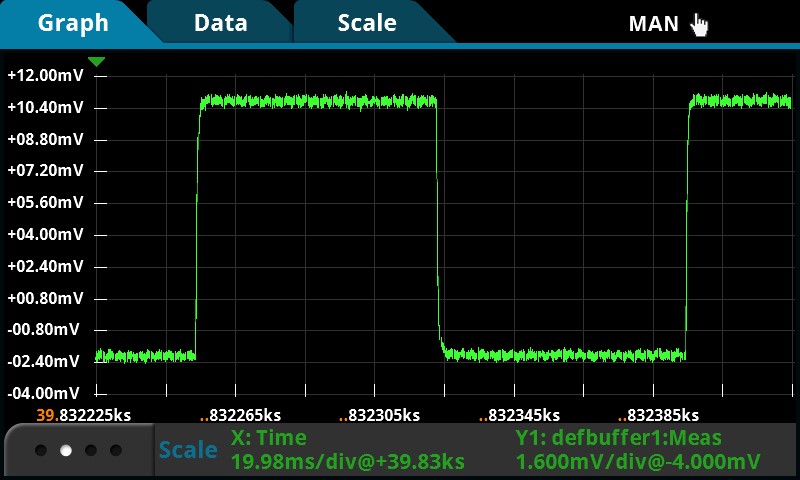
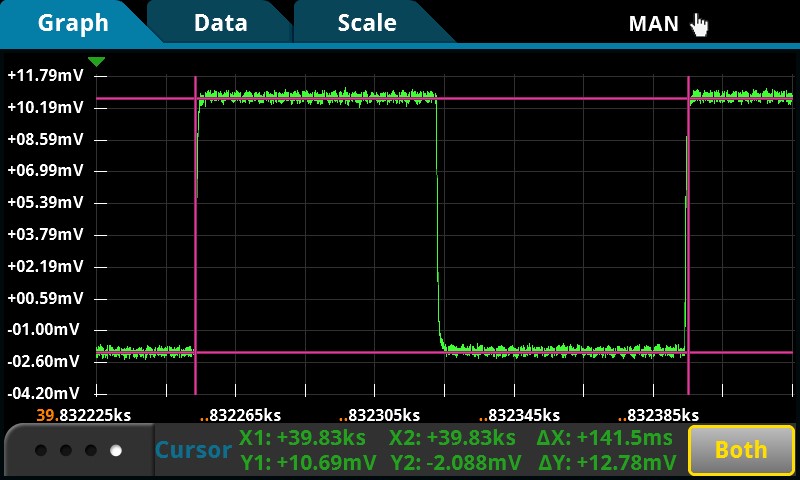
I tested a 13mW resistor. The 2450 used a test current of 1A. With 1 NPLC integration rate set on the 2450, the period was 141.5ms. The DY value of 12.78mV reasonably agrees with the 12.96mW value displayed on the 2450 (V/I). With the SourceMeter, I can adjust both the current levels and the period if needed.
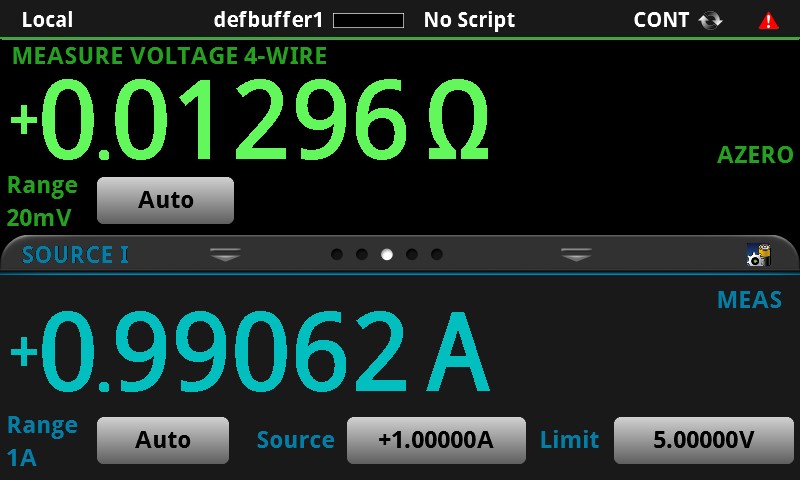
What is the Delta Mode Method?
When the thermoelectric voltages are constant with respect to the measurement cycle, the current-reversal or offset compensation method will successfully compensate for these offsets. However, if changing thermoelectric voltages are causing inaccurate results, then the delta method should be used. The delta method is similar to the current-reversal method in terms of alternating the current source polarity, but it differs in that it uses three voltage measurements to make each resistance calculation. This method can best be explained through an illustration and mathematical computations.
Figure below shows the voltage drop of a DUT as a function of time with an alternating polarity current applied.

A voltage measurement (VM1, VM2, VM3, etc.) is taken each time the polarity is changed. Each voltage measurement includes a constant thermal voltage offset (VEMF) and a linearly changing voltage offset (dV). The thermal voltage drift may be approximated as a linear function over short periods, so the rate of change of voltage as a function of time (dV) can also be treated as a constant. The first three voltage measurements include the following voltages:
VM1 = V1 + VEMF
VM2 = V2 + VEMF + dV
VM3 = V3 + VEMF + 2dV
where: VM1, VM2, and VM3 are voltage measurements
VM1 is presumed to be taken at time = 0
V1, V2, and V3 are the voltage drop of the DUT due to the applied current
VEMF is the constant thermoelectric voltage offset at the time the VM1 measurement is taken
dV is the thermoelectric voltage change
Cancellation of both the thermoelectric voltage offset (VEMF) term and the thermoelectric voltage change (dV) term is possible through mathematical computation using three voltage measurements. First, take one-half the difference of the first two voltage measurements and call this term VA:

Then, take one-half the difference of the second (VM2) and third (VM3) voltage measurements and call this term VB:

Both VA and VB are affected by the drift in the thermoelectric EMF, but the effect on VA and VB is equal and opposite. The final voltage reading is the average of VA and VB and is calculated as:

Notice that both the VEMF and dV terms are canceled out of the final voltage calculation.
In the delta method, each data point is the moving average of three voltage readings. This additional averaging of the voltage measurements means that the data resulting from the delta method has lower noise than the data derived when the current-reversal or offset compensation method is used to calculate it, even when both sets of data are taken over the same time period.
The success of the delta method depends on the linear approximation of the thermal drift, which must be viewed over a short period. Compensating successfully for changing thermoelectric voltages dictates that the measurement cycle time must be faster than the thermal time constant of the DUT. A SourceMeter such as the 2450 has a fast current source and voltmeter so that the delta method can be successful used. This technique can easily be programmed using a TSP® script with the 2450.
You can find more information on the Touchscreen Keithley SourceMeters, including the new Model 2461, on the Graphical Source Measure Unit product page. For more details on Low Resistance Measurements, check out this application note that shows one of these Sourcemeters in action.


